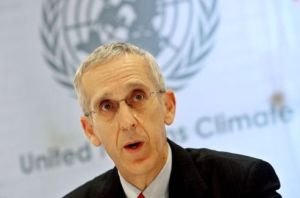 Back in the day when the dominant global negotiation focussed on trade liberalisation rather than climate protection, the then US trade representative (and now World Bank President) Robert Zoellick ruffled European feathers by appearing ambivalent as to the future of the WTO process. Even in 2001, before the ill-fated Doha ‘development’ round of talks was launched, the US made it clear that bilateral or regional agreements would serve the US well in the absence of successful multilateralism.
Back in the day when the dominant global negotiation focussed on trade liberalisation rather than climate protection, the then US trade representative (and now World Bank President) Robert Zoellick ruffled European feathers by appearing ambivalent as to the future of the WTO process. Even in 2001, before the ill-fated Doha ‘development’ round of talks was launched, the US made it clear that bilateral or regional agreements would serve the US well in the absence of successful multilateralism.
Fastforward ten years and Todd Stern, the US’s chief climate negotiator, is making similar pronouncements about the perhaps equally ill-fated UN climate negotiations. The latest round, held in Bangkok, were, according to Stern, ‘marked by struggles over the agenda’ and ‘bickering over the shape of the negotiating table.’ In an address to a Bloomberg New Energy Finance conference, lawyer Stern said:
‘Legally binding international obligations to cut emissions are not necessary. It is the national plans of countries, written into law and regulations, that count and that bind.’
Meanwhile, over in South Africa, which will host this year’s climate ministerial in late Novermber, an EU envoy was delivering an altogether different-sounding message. Swedish environment minister Andreas Carlgren told his South African hosts:
‘The most important discussions will be around a legally binding global framework. The EU wants a second commitment under Kyoto and developed countries to commit to emissions reductions.’
The objectives of trade liberalisation and climate protection may appear very different, but many of the barriers (adjustment costs, the pleading of powerful interest groups, becoming or remaining competitive) and apparently aspects of the global politics are the same.
Back in December, I wrote in an article published in the UK’s Sunday Times that it was time to shift the objectives of climate advocacy away from the multilateral negotiations and towards alligning climate and national interests. ‘The task is no longer about targets to cut emissions, but about defining how a more secure and growing economy can also be a low-carbon economy.’
I agree with Stern, but reluctantly since it’s not at all clear how domestic narratives can be constructed to support the bottom-up effort, most notably in the US; climate-based arguments are as yet little more successful in capital cities than in convention rooms.
It’s worth paying heed to the experience of the WTO, from which political capital ebbed away at an alarming rate once the dust storm in Doha had settled down and negotiations hit grinding realpolitik first in Cancun and then in Hong Kong. There’s been plenty of trade liberalisation since, but not under the aegis of new WTO agreements (advocates of climate action take note). Some are still trying to revive Doha, but this seems Quixotic.
Increasingly those hoping for a revival in the fortunes of the UN climate talks and for a second Kyoto commitment period involving any other party than the EU appear also to be tilting at windmills. Perhaps the considerable efforts and resources of the climate change research and policy community should now be aimed mainly at raising the game at the national level; not as a means to a multialteral end, but as an end in itself.


One can easily indulge in a bottom-up complacency if one discards achieving climate stability at an acceptable numerical level. This does not seem to be a do-your-best game. This is a stability achieving game. If no decent climate stability is achieved after investing billions and trillions for tech and innovation, this is neither politically untenable nor correct.
Best way to achieve national interests and global climate stability is to cap globally with emissions that ensure stability, sell allowances and let the market do the job, obtain new revenues from such sales and use them for innovation and for poorer countries to adapt.
To bind governments to reduce emissions of their private enterprises is archaic and painful. To let the market do the job is effective, modern and gainful.
So the question is not whether it is multilateral or bilateral. It is whether one method is more capable to achieve global climate stability without hurting national interests than other.
Dear Yoshi
Thanks for your comment – it’s an honour for us to receive interest from such and important player at the international level.
In principle, of course, you’re right. But apparently the politics simply don’t support running at the international level before countries have learnt to walk at home. The same dynamic has ground the WTO negotiations into the ground and I’m merely taking a long, historic view of multilateralism to argue that pinning our hopes on this process might in the end do more harm than good.
But please don’t take this to imply that I don’t think multilateralism is desirable. I do, but can’t see where its immediate future lies.
Andrew.
Pingback: Link Loving 06.05.11 « Casper ter Kuile